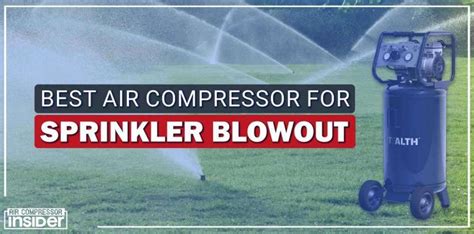Best Practices: Choosing a Compressor for Sprinkler Blowout
Winterizing your sprinkler system is crucial to prevent costly damage from freezing pipes. A key component of this process is using an air compressor to blow out the water. Choosing the right compressor can make the difference between a quick, efficient job and a frustrating, potentially damaging one. This guide will walk you through the best practices for selecting a compressor for your sprinkler blowout needs.
What Size Compressor Do I Need for Sprinkler Blowout?
This is the most common question, and the answer isn't a simple number of CFM (Cubic Feet per Minute). You need to consider several factors:
- System Size: A larger sprinkler system with more zones and longer lines requires a compressor with a higher CFM rating. Smaller systems can get away with a smaller compressor.
- Line Diameter: Larger diameter pipes require more air pressure and volume to effectively clear water. A higher CFM and PSI (Pounds per Square Inch) rating is necessary for larger lines.
- Desired Speed: A higher CFM rating will result in a faster blowout, saving you time and effort. However, this also increases the risk of damaging your system if not done correctly.
Instead of focusing solely on CFM, consider the total air volume needed to effectively clear your system. Many professionals recommend compressors with a minimum of 5 CFM @ 90 PSI for most residential systems. Larger commercial systems might require significantly more.
What PSI is Needed for Sprinkler Blowout?
While CFM is critical for moving the air, PSI is equally important for pushing the water out of the lines. Aim for a compressor that can reach at least 90 PSI. This pressure is generally sufficient for most residential systems. Going higher isn't necessarily better; excessive pressure can damage sprinkler heads and pipes.
Should I Use an Oil-Lubricated or Oil-Free Compressor?
Both oil-lubricated and oil-free compressors have their advantages and disadvantages:
- Oil-Lubricated: These compressors are typically more powerful and durable, offering higher CFM and PSI outputs for less cost. However, they require regular oil changes and maintenance, adding to the overall cost of ownership. There's also a slight risk of oil contaminating the water lines.
- Oil-Free: Oil-free compressors are easier to maintain and are less prone to contamination. They are quieter, making them a better choice for residential settings. However, they typically have lower CFM and PSI outputs, and can be more expensive for the same power rating.
For most homeowners, an oil-free compressor offers a good balance of performance and convenience.
What Other Features Should I Consider?
Beyond CFM and PSI, consider these features:
- Tank Size: A larger tank provides a more consistent air supply, preventing pressure drops during the blowout process.
- Portability: If you have a large property, a portable compressor with wheels will be more convenient.
- Automatic Start/Stop: This feature helps save energy and extends the compressor's lifespan.
- Pressure Regulator: A precise pressure regulator allows you to control the air pressure, minimizing the risk of damage.
How Many CFM Do I Need for a Specific Size Sprinkler System?
This question is difficult to answer precisely without specifics on your system's size and pipe diameter. A professional sprinkler technician can provide a more accurate assessment of your needs. As a general guideline:
- Small Systems (under 5 zones, small diameter pipes): 3-5 CFM @ 90 PSI
- Medium Systems (5-10 zones, medium diameter pipes): 5-8 CFM @ 90 PSI
- Large Systems (over 10 zones, large diameter pipes): 8+ CFM @ 90 PSI
Always consult with a sprinkler professional if you are unsure about the appropriate compressor size for your system. Incorrectly sizing the compressor can lead to incomplete blowouts, leaving water in the lines and increasing the risk of freezing.
What are the potential consequences of using an underpowered compressor for sprinkler blowout?
Using an underpowered compressor can result in incomplete water removal from your sprinkler lines, leading to freezing and damage during winter. This can cause costly repairs, including broken pipes and sprinkler heads.
Can I use a small, portable compressor for my sprinkler blowout?
Small, portable compressors may suffice for very small sprinkler systems. However, for most residential systems, they likely lack the CFM and PSI needed for a complete and efficient blowout. Using an underpowered compressor risks incomplete water removal, potentially leading to damage.
This comprehensive guide should help you choose the right air compressor for your sprinkler blowout needs. Remember that consulting a professional is always a good idea to ensure you have the right equipment for the job and avoid potential damage to your valuable sprinkler system.

